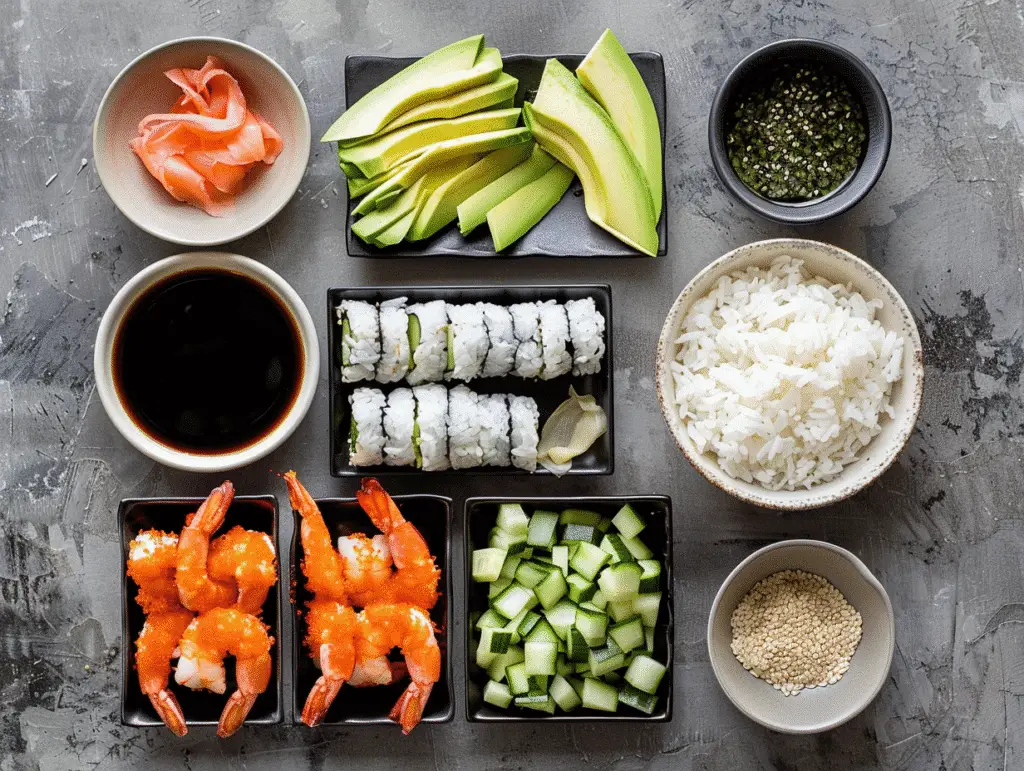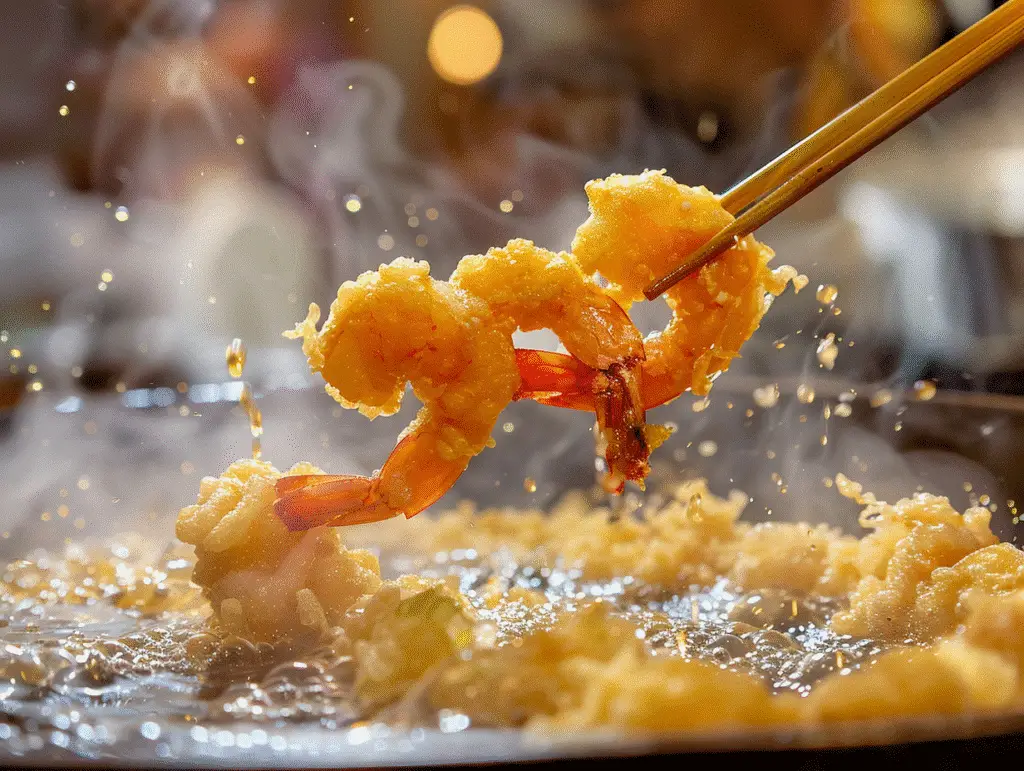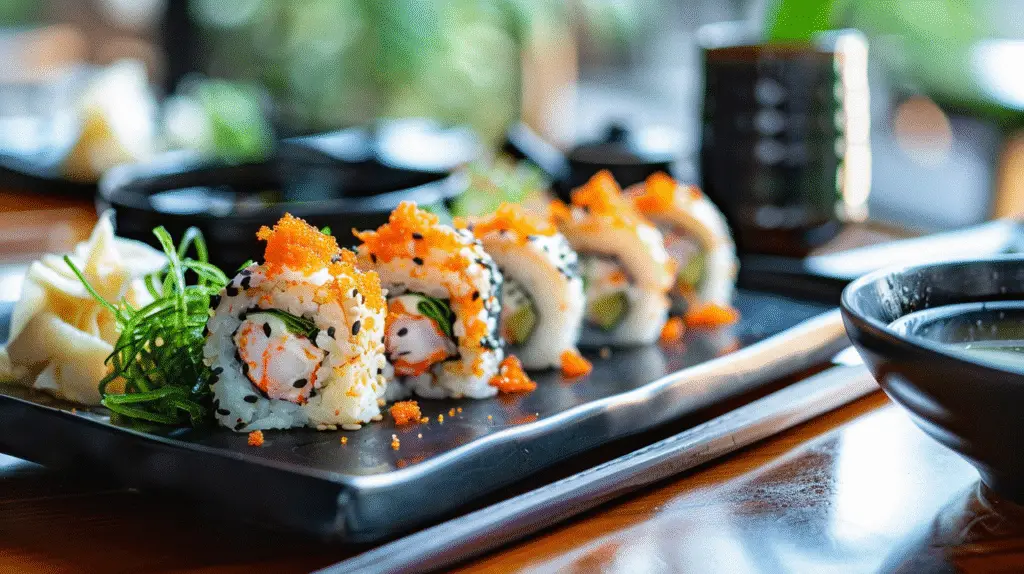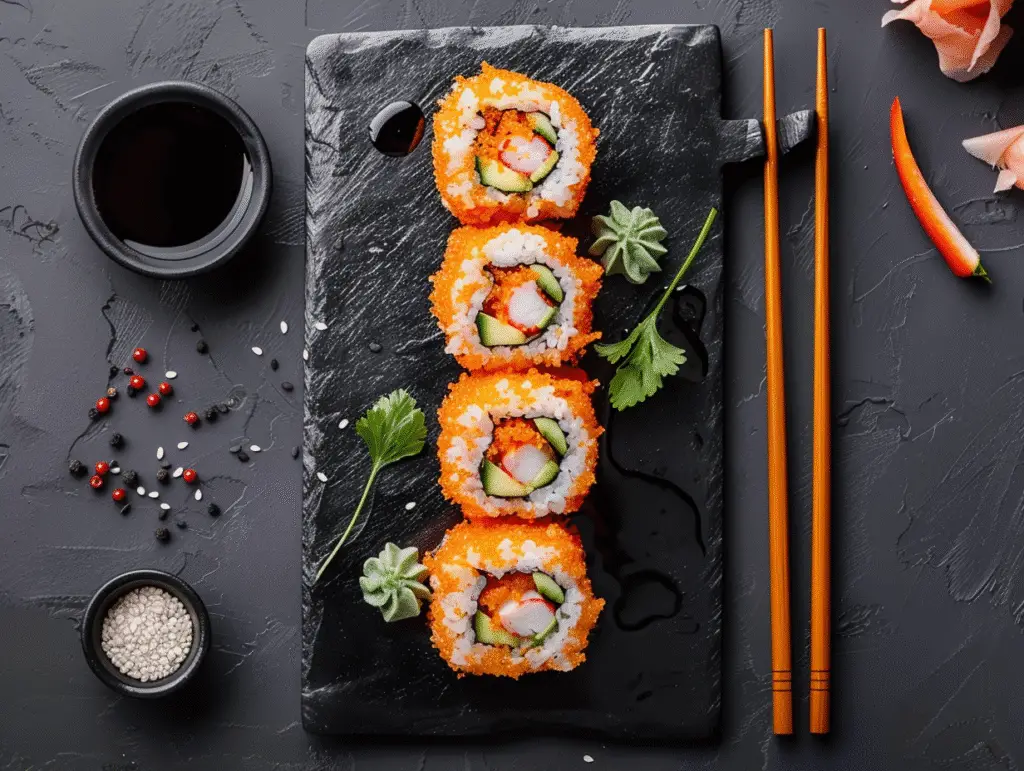There’s something magical about that first crunchy bite of a shrimp tempura sushi roll. The golden, airy batter shatters, giving way to sweet shrimp, creamy avocado, and the gentle tang of seasoned rice. I still remember the rainy Portland night I first tasted one — steam curling from my miso soup, the roll glistening under a drizzle of eel sauce. Since then, this sushi roll has been my favorite way to introduce friends to Japanese flavors. In this guide, we’ll share its story, why it’s so popular, and how you can make it at home.
Print
Shrimp Tempura Sushi Roll: Crispy, Flavor-Packed Sushi You’ll Love
- Total Time: 30 minutes
- Yield: 4 servings 1x
Description
A crispy and creamy sushi favorite, this shrimp tempura sushi roll combines golden tempura shrimp with fresh vegetables, seasoned rice, and savory sauces.
Ingredients
8 large shrimp, peeled and deveined
1 cup tempura batter mix
1 cup ice-cold water
1 cup sushi rice, cooked and seasoned
4 sheets nori
1 avocado, sliced
1/2 cucumber, cut into thin strips
Spicy mayo, eel sauce for topping
Oil for frying
Instructions
Pat shrimp dry and prepare tempura batter with ice-cold water.
Heat oil to 350°F and fry shrimp until golden and crisp.
Place a sheet of nori on a bamboo mat, shiny side down.
Spread sushi rice evenly over nori, leaving 1 inch at the top.
Lay shrimp tempura, avocado, and cucumber across the bottom.
Roll tightly using the bamboo mat.
Slice into 8 pieces and drizzle with spicy mayo and eel sauce.
Notes
Serve immediately for best texture.
Can substitute brown rice for a healthier twist.
Double the tempura shrimp for an extra crunchy roll.
- Prep Time: 20 minutes
- Cook Time: 10 minutes
- Category: Sushi
- Method: Frying and Rolling
- Cuisine: Japanese
Nutrition
- Serving Size: 2 rolls
- Calories: 480
- Sugar: 5g
- Sodium: 820mg
- Fat: 18g
- Saturated Fat: 3g
- Unsaturated Fat: 12g
- Trans Fat: 0g
- Carbohydrates: 64g
- Fiber: 4g
- Protein: 22g
- Cholesterol: 95mg
Keywords: shrimp tempura sushi roll, tempura shrimp sushi

Table of Contents
A Crunchy Bite of Memory
From Kitchen to Sushi Bar
When I was younger, sushi intimidated me — the thought of raw fish made me hesitate. But the first time I ordered a shrimp tempura sushi roll, everything changed. The shrimp was perfectly cooked, coated in a light batter that reminded me of my mom’s fried catfish, only softer and airier. Nestled in sushi rice and wrapped in nori, it offered a harmony of textures and flavors I’d never experienced before. If you’ve enjoyed dishes like my crispy coconut shrimp or pan-seared salmon with soy glaze, you’ll understand the joy of that first bite.
The Allure of the Crunch
Part of this roll’s charm is how it bridges the gap between traditional Japanese sushi and the American love for fried food. Tempura’s delicate crunch adds excitement without overpowering the shrimp’s natural sweetness. Many restaurants dress a shrimp tempura sushi roll with spicy mayo, eel sauce, or even slices of avocado on top, turning it into a mini feast. And unlike sashimi or nigiri, it feels comforting — a safe, flavorful gateway for sushi newcomers. It’s why, much like my teriyaki chicken bowl, this sushi roll has become a permanent fixture in my dinner rotation.
Inside the Shrimp Tempura Sushi Roll
What’s Inside the Roll
At its core, a shrimp tempura sushi roll is a balance of crisp, creamy, and fresh. The star, of course, is the shrimp tempura — lightly battered and fried until golden. It’s rolled with seasoned sushi rice, a sheet of nori, and usually a few fresh vegetables like cucumber or avocado. The combination creates a contrast between the crunchy shrimp and the soft rice, with the vegetables adding a refreshing bite. Some versions tuck in a little cream cheese for richness, while others go bold with jalapeño slices for a gentle kick. I’ve found it similar in satisfaction to my spicy tuna sushi roll, though the textures couldn’t be more different.
Popular Variations Worth Trying
Once you’ve had the classic shrimp tempura sushi roll, it’s tempting to try the many variations found in sushi restaurants. The Dragon Roll layers ripe avocado and eel sauce over the top, creating a glossy, savory-sweet finish. A Volcano Roll takes the same base and crowns it with baked seafood and spicy mayo, turning each bite into a flavor explosion. If you prefer a lighter touch, some chefs swap white rice for brown or use thin cucumber slices instead of nori for a refreshing, low-carb twist. At home, I’ve paired this roll with my homemade sushi rice guide, and the results are just as satisfying as in a restaurant.
Mastering the Tempura Technique
What Exactly Is Tempura?
Tempura is a centuries-old Japanese cooking method that transforms seafood and vegetables into light, crispy bites. The secret lies in a thin batter made from cold water, flour, and sometimes egg. For a shrimp tempura sushi roll, the batter coats the shrimp without overpowering it, allowing the natural sweetness of the seafood to shine. The quick fry at high heat locks in moisture while creating that irresistible crunch. It’s the same principle I use when making my crispy vegetable tempura at home — light, airy, and never greasy.
Tips for Perfect Shrimp Tempura at Home
Recreating the texture of restaurant-style shrimp tempura requires a few simple tricks. First, keep your batter ice-cold; this helps create the signature airy crust. Second, pat the shrimp dry before dipping to prevent sogginess. Finally, fry in small batches so the oil temperature stays steady. Once fried, let the shrimp rest briefly on a wire rack to keep them crisp before rolling them into your sushi. I often prepare extra tempura shrimp to snack on while assembling the rolls — they taste just as good on their own as they do inside a shrimp tempura sushi roll. When paired with a tangy dipping sauce, it’s a treat that disappears fast, much like my panko fried fish on family fish fry nights.

Nutrition and Serving Ideas

Is Shrimp Tempura Sushi Roll Healthy?
While a shrimp tempura sushi roll offers plenty of flavor, it’s also higher in calories and fat than raw fish rolls due to the frying process. A typical serving can range from 450–500 calories, with most of the fat coming from the tempura batter and sauces. The shrimp itself is a great source of lean protein, and the avocado adds heart-healthy fats. If you’re looking to make it lighter, you can bake the tempura shrimp instead of frying, use less sauce, or swap white rice for brown rice. These adjustments can make your homemade shrimp tempura sushi roll closer to an everyday option rather than an occasional indulgence.
How to Serve & Pair Your Roll
Serving a shrimp tempura sushi roll is all about balance. Pair it with lighter sides like miso soup, seaweed salad, or edamame to round out the meal without adding too many extra calories. A drizzle of eel sauce or a touch of spicy mayo can add richness, while pickled ginger and wasabi keep the flavors lively. When I make sushi nights at home, I like to serve this roll alongside my California sushi roll and homemade miso soup for a full Japanese-inspired spread.
Conclusion
A shrimp tempura sushi roll is the perfect blend of crispy, savory, and fresh. Its cooked shrimp filling makes it approachable for sushi beginners, while the textures and flavors keep seasoned sushi lovers coming back. Whether you’re enjoying it at your favorite restaurant or making it at home, this roll delivers comfort and satisfaction in every bite. By mastering tempura shrimp, experimenting with variations, and pairing it with light sides, you can turn a simple roll into a complete, delicious meal that’s worth savoring again and again.
for more recipes follow me in facebook ,Home Page
FAQs
What’s in a shrimp tempura sushi roll?
It typically contains tempura-battered shrimp, sushi rice, nori, cucumber or avocado, and often sauces like spicy mayo or eel sauce.
Is shrimp tempura sushi raw or cooked?
It’s fully cooked. The shrimp is fried in tempura batter before being rolled with rice and nori.
What exactly is shrimp tempura?
Shrimp tempura is shrimp coated in a light, airy batter and fried until golden and crisp.
Is shrimp tempura sushi roll healthy?
It’s richer than raw sushi due to frying but still provides lean protein. Lighter cooking methods and reduced sauce can make it healthier.




